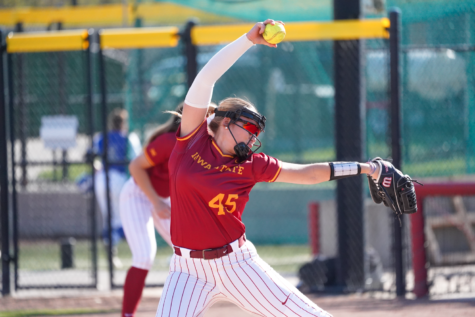15 years later, a cross country team is remembered
November 30, 2000
Two and a half miles away from Des Moines International Airport, a small plane carrying athletes, coaches, a trainer and the pilot of the 1985 ISU women’s cross country team descended rapidly from the November sky.
It then sheared off the top of a tree, which stood in a residential area, and shot through an oak tree and an evergreen. The Rockwell Aerocommander then came to rest upside-down in a ball of fire in a front yard.
All on board were killed.
Fifteen years later, removed some 200 yards from the hustle and bustle of the 2000 NCAA Cross Country Championships in Ames, sits a plaque on a rock.
Written in memory on the plaque are the names of the head and assistant coaches: Ron Renko and Pat Moynihan; the three student-athletes: Susan Baxter, Sheryl Maahs and Julie Rose; the student-trainer: Stephanie Streit; and pilot Burt Watkins, who all died on Nov. 25, 1985.
They were returning from the NCAA Cross Country Championships, where the team had finished second.
Standing next to the rock with a plaque on it, whispering a prayer, is Brigham Young University women’s cross country coach Patrick Shane.
“Ron was a good friend of mine,” Shane said. “Not a year goes by where I don’t think about it.”
Jeff Butts, online news editor at omaha.com, a subsidiary of the Omaha World Herald, said his mind fills with memories when “Ain’t Nothing Gonna Break My Stride” plays on the radio.
Renko adopted the song as the team anthem.
The memorial service at Hilton Coliseum, 10 days after the crash, began with it.
Butts, who co-wrote the initial article about the crash for the Iowa State Daily, described the memorial service as “bittersweet.”
Interspersed with the upbeat song were the muffled sounds of laughter and tears of the near 5,500 in attendance.
There were about 9,000 on-lookers at the NCAAs a week-and-a-half earlier.
The air was chilly, and the course was enveloped with snow.
Coaches, armed with shovels, took to the 3.1-mile Marquette University terrain early to clear a path.
Despite running through a course that was only four feet wide in spots, according to the Des Moines Register, Maahs, Rose and Baxter ran the best-timed races of their lives.
A fourth ISU runner, Bonnie Sons, ran the second-fastest she ever had.
The team had hoped to finish in the top five. They thought they had finished third and were giddy with joy when they finished second.
Sons left on an earlier plane that day — one of two that transported ISU men’s and women’s runners home.
It was decided the third flight would remain for the award ceremonies that were going to take place.
The third plane was supposed to land in Ames at one of the two landing strips.
The first was under construction. The second was under a sheet of ice.
So Watkins, the pilot, detoured and was instructed to land in Des Moines.
At 5:41 CST, Watkins told the Des Moines tower he was experiencing “severe turbulence.”
Twenty-seven seconds later, the last of the frantic transmissions fell flat, as heard on the tape made at the tower. Silence.
Rose and Baxter were from England, and “I had to call the families,” said Max Urick, ISU athletics director at the time.
Rose’s parents did not believe him, Urick said.
Her father hung up on Urick the first time he called.
Urick then had to speak at the memorial service, which was the “most difficult thing I’ve ever done. They were a great team,” he said, choking back tears.
Lawsuits were filed two years later by the victims’ families against the state claiming “negligence” on Watkin’s behalf.
The National Transportation and Safety Board said the probable cause of the crash was ice on the wings.
The cases were settled out of court.
Ringing louder than the legal battles were the memories.
“I still get teary when I think about that group,” Urick said.
















